Distributed Modeling of Isolated Active Magnetic Bearings Considering Magnetic Leakage and Material Nonlinearity
Abstract
:1. Introduction
2. Configuration and Principle
3. Magnetic Model and Calculation Procedures
3.1. Establishment of Distributed Magnetic Circuit Model
3.2. Calculation of Axial Segmental Magnetic Network
3.2.1. Calculation of Reluctance of Isolation Sleeves
3.2.2. Calculation of Reluctance of Air Gap
3.2.3. Calculation of Magnetic Flux and Suspension Forces
3.2.4. Iterative Calculation and Nonlinearity of Materials
4. Simulation by 3D FEM and Experimental Validations
4.1. 3D FEM Model
4.2. Experimental Platform and Control System
4.3. Suspension Experiment
4.4. Stiffness Comparison Experiment
4.4.1. Relationship of Force-Current
4.4.2. Relationship of Force-Displacement
5. Conclusions
Author Contributions
Funding
Data Availability Statement
Conflicts of Interest
References
- Falkowski, K.; Kurnyta-Mazurek, P.; Szolc, T.; Henzel, M. Radial Magnetic Bearings for Rotor–Shaft Support in Electric Jet Engine. Energies 2022, 15, 3339. [Google Scholar] [CrossRef]
- Wang, D.; Wang, N.; Ye, C.; Chen, K. Research on analytical bearing capacity model of active magnetic bearing based on magnetic saturation. IET Electr. Power Appl. 2017, 11, 1548–1557. [Google Scholar] [CrossRef]
- Uzhegov, N.; Smirnov, A.; Park, C.H.; Ahn, J.H.; Heikkinen, J.; Pyrhönen, J. Design Aspects of High-Speed Electrical Machines with Active Magnetic Bearings for Compressor Applications. IEEE Trans. Ind. Electron. 2017, 64, 8427–8436. [Google Scholar] [CrossRef]
- Smirnov, A.; Uzhegov, N.; Sillanpää, T.; Pyrhönen, J.; Pyrhönen, O. High-Speed Electrical Machine with Active Magnetic Bearing System Optimization. IEEE Trans. Ind. Electron. 2017, 64, 9876–9885. [Google Scholar] [CrossRef]
- Le, Y.; Fang, J.; Wang, K. Design and optimization of a radial magnetic bearing for high speed motor with flexible rotor. IEEE Trans. Magn. 2015, 51, 8300313. [Google Scholar]
- Wang, X.; Zhang, Y.; Gao, P. Design and Analysis of Second-Order Sliding Mode Controller for Active Magnetic Bearing. Energies 2020, 13, 5965. [Google Scholar] [CrossRef]
- Jiang, D.; Li, T.; Hu, Z.; Sun, H. Novel Topologies of power electronics converter as active magnetic bearing drive. IEEE Trans. Ind. Electron. 2020, 67, 950–959. [Google Scholar] [CrossRef]
- Sun, Y.; Ho, Y.; Yu, L. Dynamic Stiffnesses of Active Magnetic Thrust Bearing Including Eddy-Current Effects. IEEE Trans. Magn. 2009, 45, 139–149. [Google Scholar] [CrossRef]
- Sun, J.; Ju, Z.; Peng, C.; Le, Y.; Ren, H. A novel 4-DOF hybrid magnetic bearing for DGMSCMG. IEEE Trans. Ind. Electron. 2017, 64, 2196–2203. [Google Scholar] [CrossRef]
- Hemenway, N.R.; Gjemdal, H.; Severson, E.L. New Three-Pole Combined Radial–Axial Magnetic Bearing for Industrial Bearingless Motor Systems. IEEE Trans. Ind. Appl. 2021, 57, 6754–6764. [Google Scholar] [CrossRef]
- Le, Y.; Sun, J.; Han, B. Modeling and Design of 3-DOF Magnetic Bearing for High-Speed Motor Including Eddy-Current Effects and Leakage Effects. IEEE Trans. Ind. Electron. 2016, 63, 3656–3665. [Google Scholar] [CrossRef]
- Shakibapour, F.; Rahideh, A.; Mardaneh, M. 2D analytical model for heteropolar active magnetic bearings considering eccentricity. IET Electr. Power Appl. 2018, 12, 614–626. [Google Scholar] [CrossRef]
- Hu, Y.; Chen, B.; Zhang, X.; Zhang, F.; Gong, G.; Li, X.; Li, L. Analysis of Electromagnetic Characteristics of 16 Pole Radial Active Magnetic Bearings. In Proceedings of the 22nd International Conference on Electrical Machines and Systems (ICEMS), Harbin, China, 11–14 August 2019; pp. 1–6. [Google Scholar]
- Han, B.C.; Zheng, S.Q. Weight-reduction design based on integrated radial-axial magnetic bearing of a large-scale MSCMG for space station application. IEEE Trans. Ind. Electron. 2017, 64, 2205–2214. [Google Scholar] [CrossRef]
- Zhu, H.Q.; Ding, S.L.; Jv, J.T. Modeling for three-pole radial hybrid magnetic bearing considering edge effect. Energies 2016, 9, 345. [Google Scholar] [CrossRef]
- Yu, C.; Deng, Z.; Mei, L.; Peng, C.; Cao, X.; Chen, S.; Ding, Q. Evaluation Criteria of Material Selection on 3-DOF Hybrid Magnetic Bearing. IEEE Trans. Ind. Appl. 2021, 57, 4733–4744. [Google Scholar] [CrossRef]
- Wang, H.; Wu, Z.; Liu, K.; Wei, J.; Hu, H. Modeling and Control Strategies of a Novel Axial Hybrid Magnetic Bearing for Flywheel Energy Storage System. IEEE/ASME Trans. Mechatron. 2022, 27, 3819–3829. [Google Scholar] [CrossRef]
- Zhang, W.; Yang, H.; Cheng, L.; Zhu, H. Modeling based on exact segmentation of magnetic field for a centripetal force type-magnetic bearing. IEEE Trans. Ind. Electron. 2020, 67, 7691–7701. [Google Scholar] [CrossRef]
- Wu, M.; Zhu, H.; Zhang, H.; Zhang, W. Modeling and Multilevel Design Optimization of an AC–DC Three-Degree-of-Freedom Hybrid Magnetic Bearing. IEEE Trans. Ind. Electron. 2023, 70, 233–242. [Google Scholar] [CrossRef]
- Cao, Z.; Huang, Y.; Guo, B.; Peng, F.; Dong, J.; Hemeida, A. A Novel Hybrid Analytical Model of Active Magnetic Bearing Considering Rotor Eccentricity and Local Saturation Effect. IEEE Trans. Ind. Electron. 2022, 69, 7151–7160. [Google Scholar] [CrossRef]

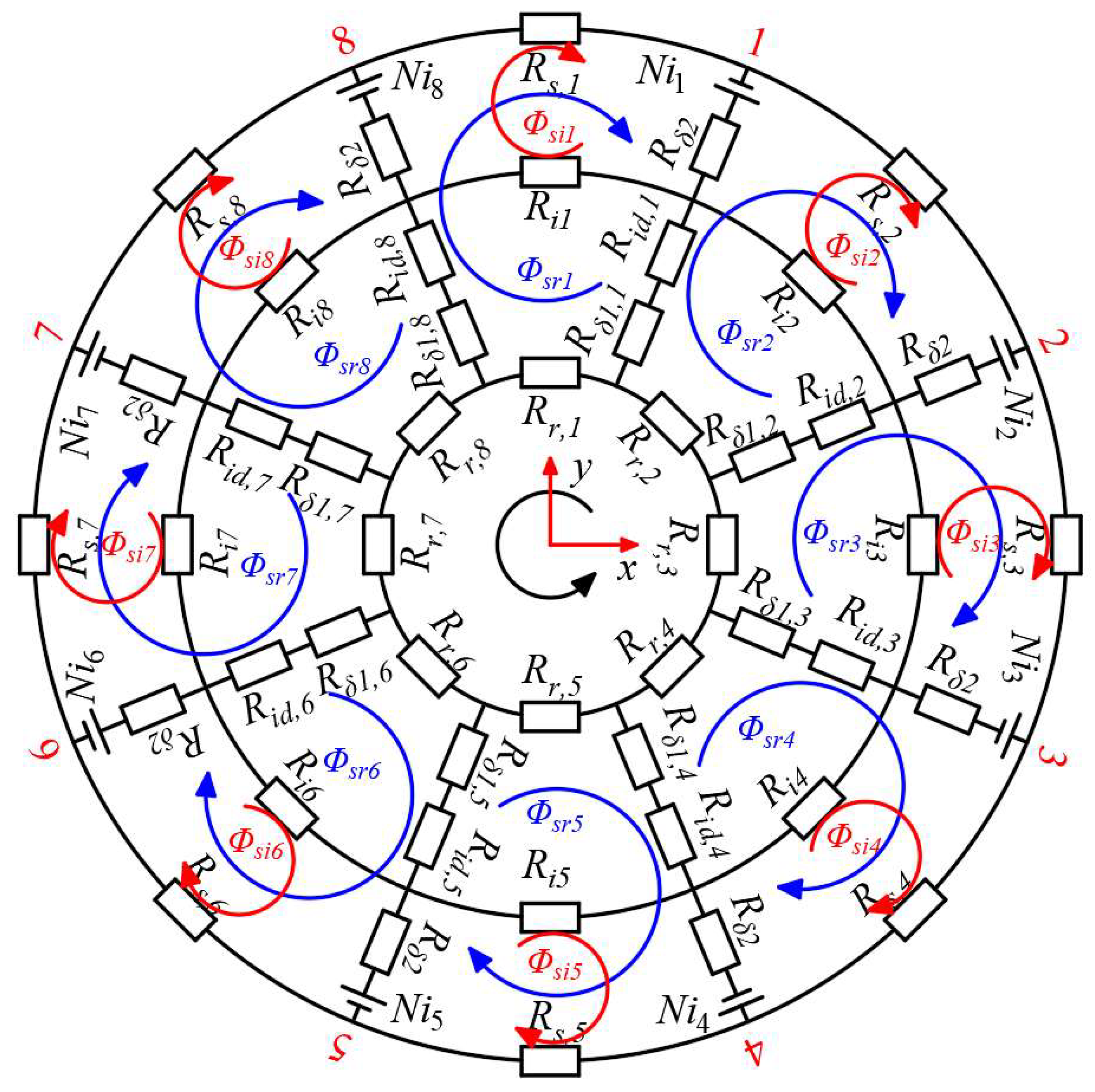
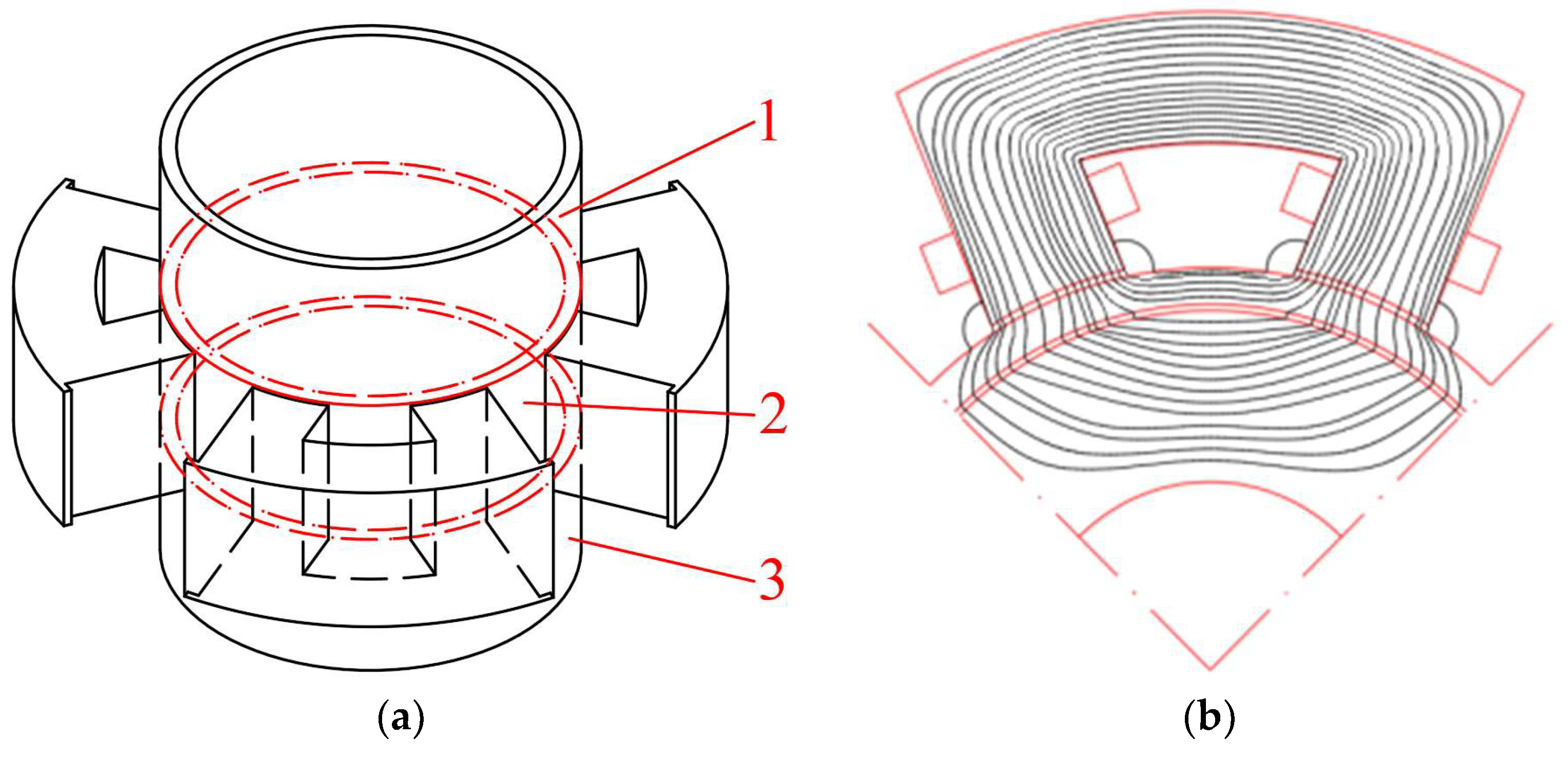
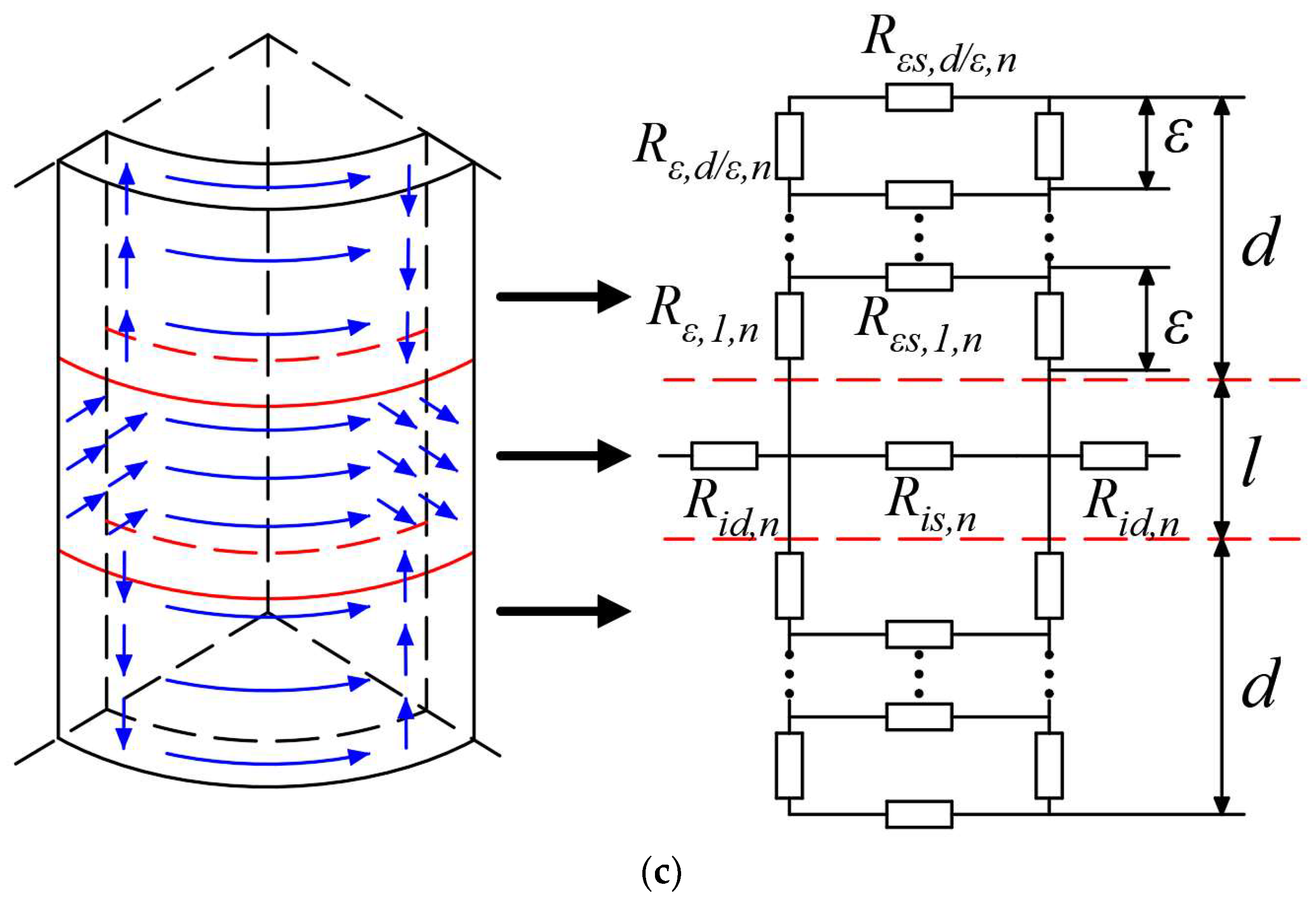
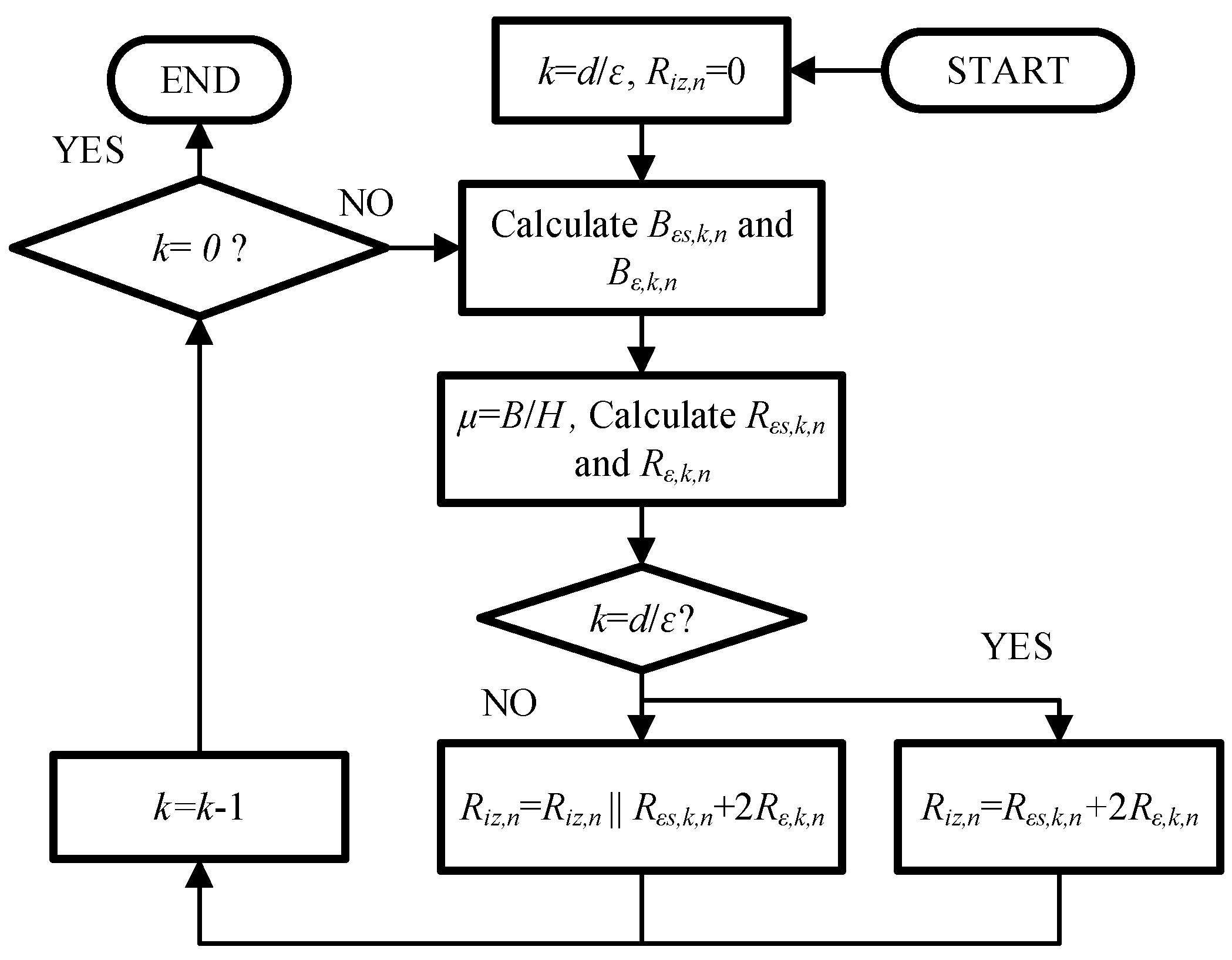
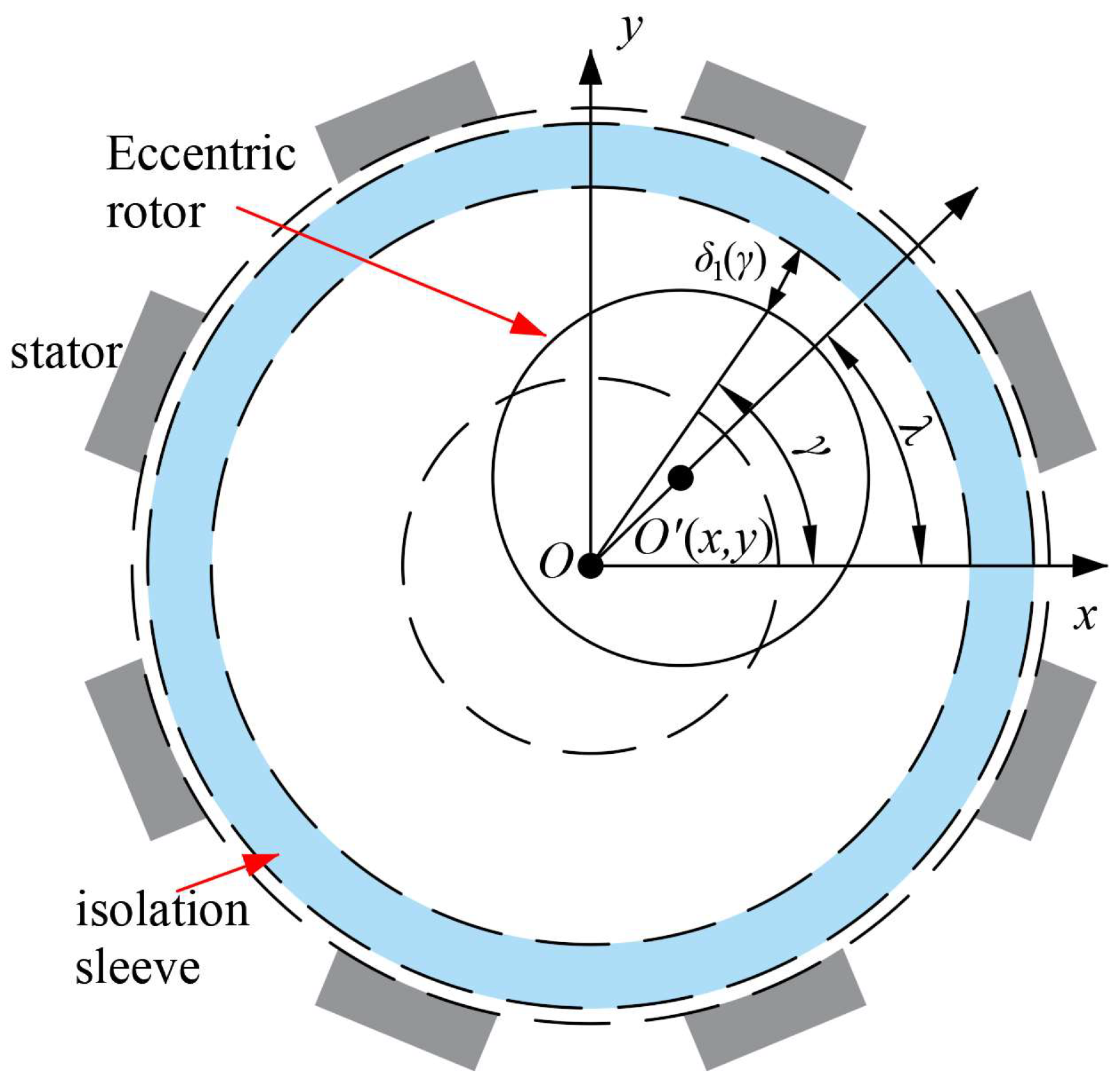

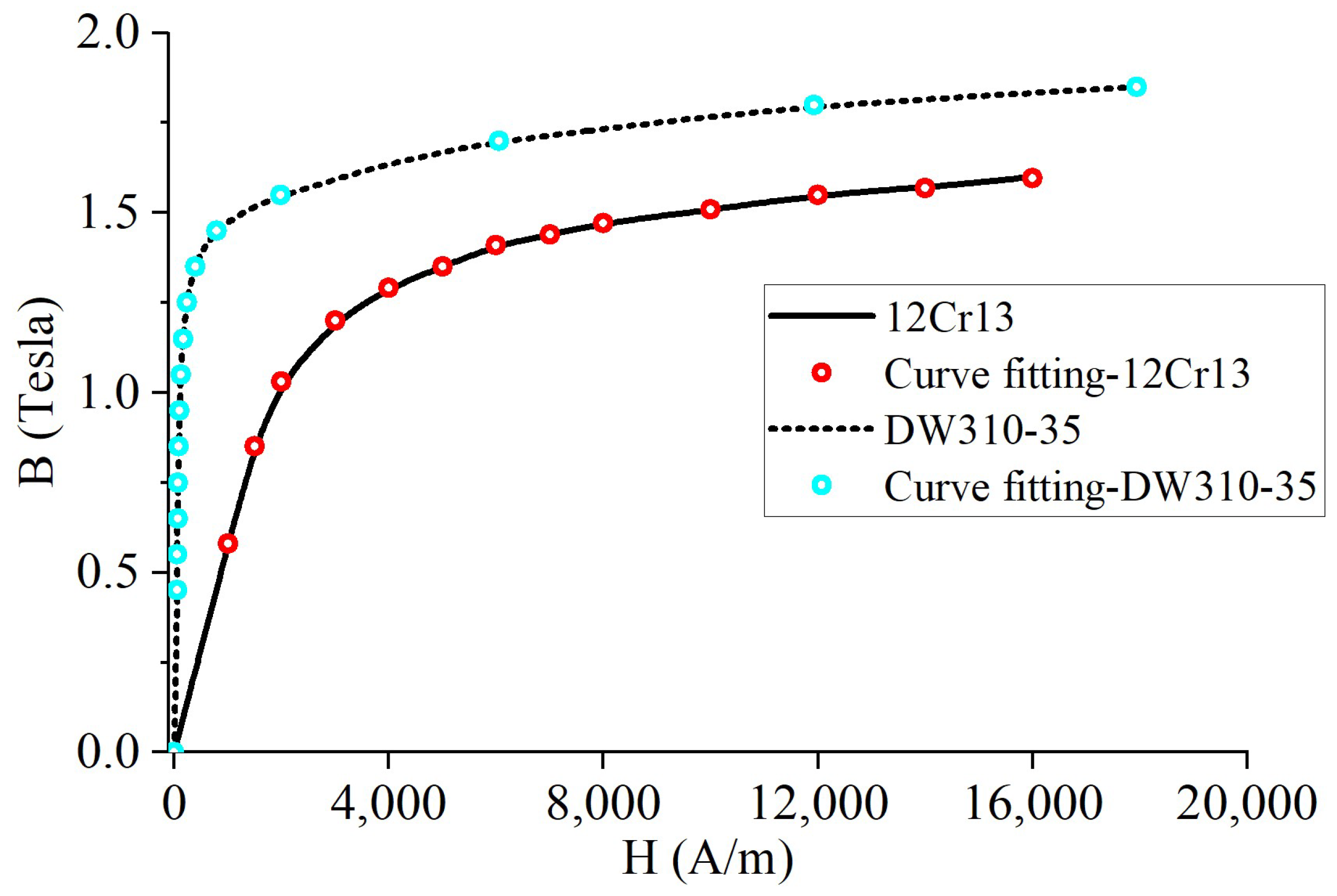

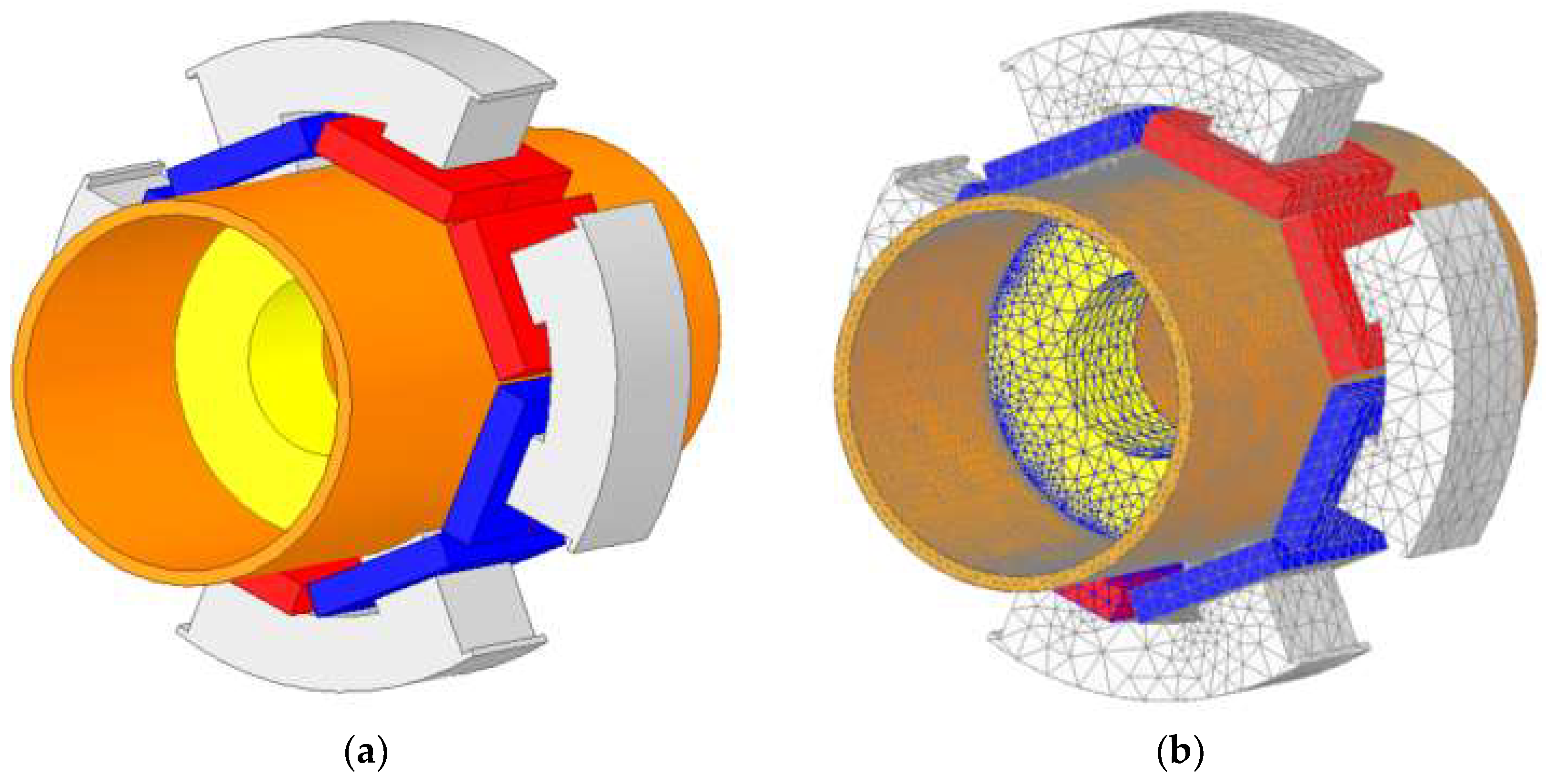

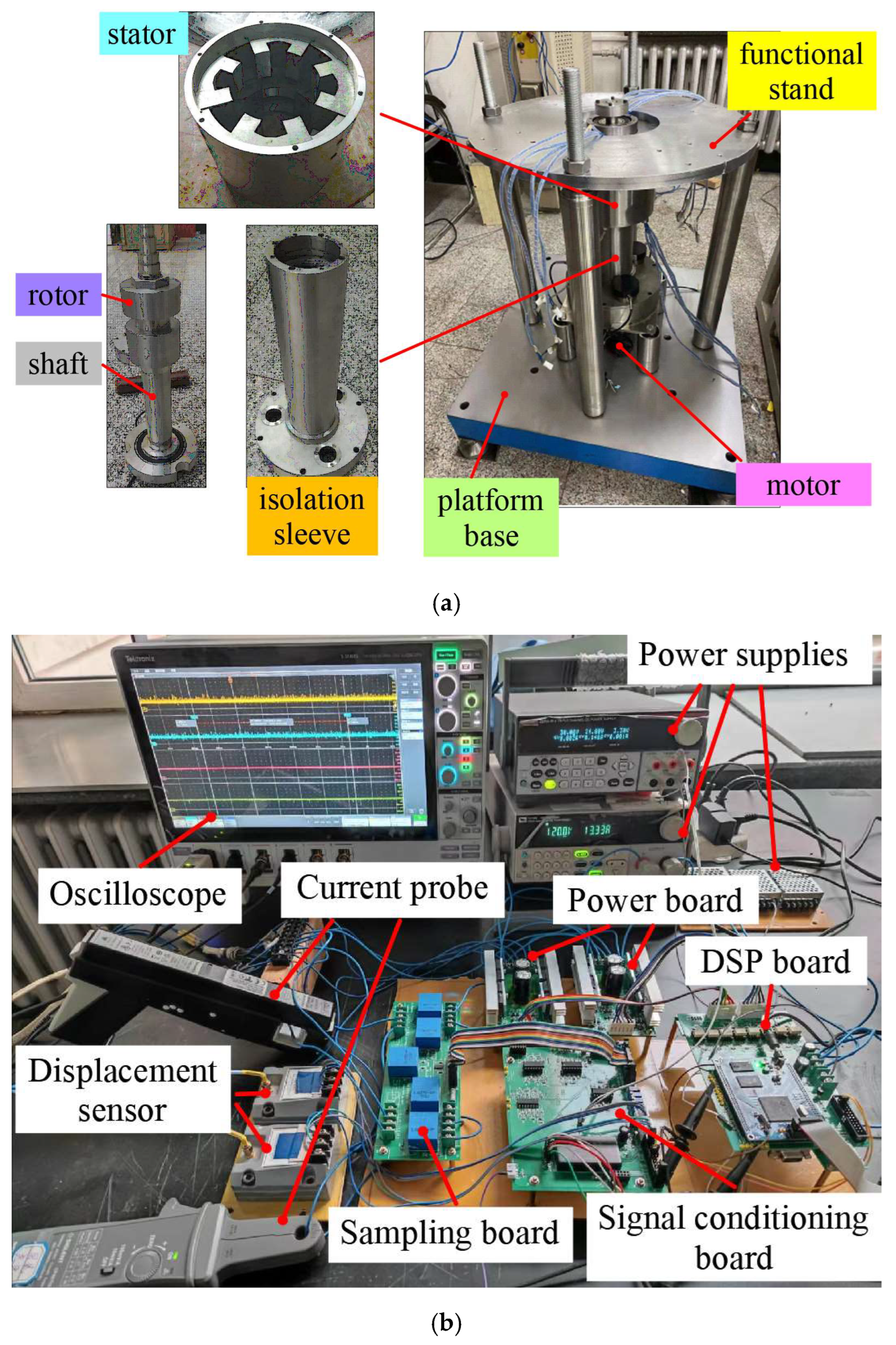
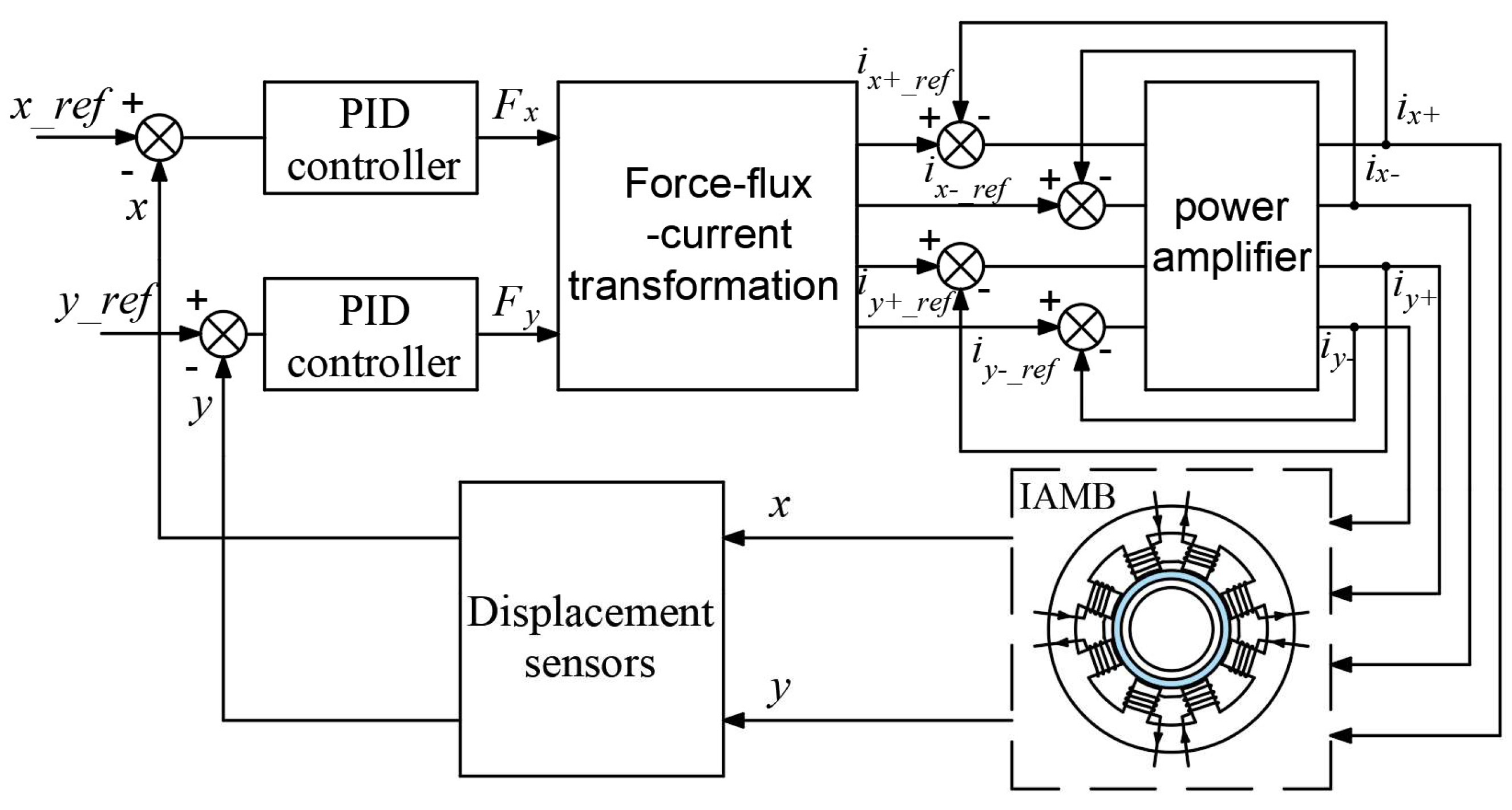

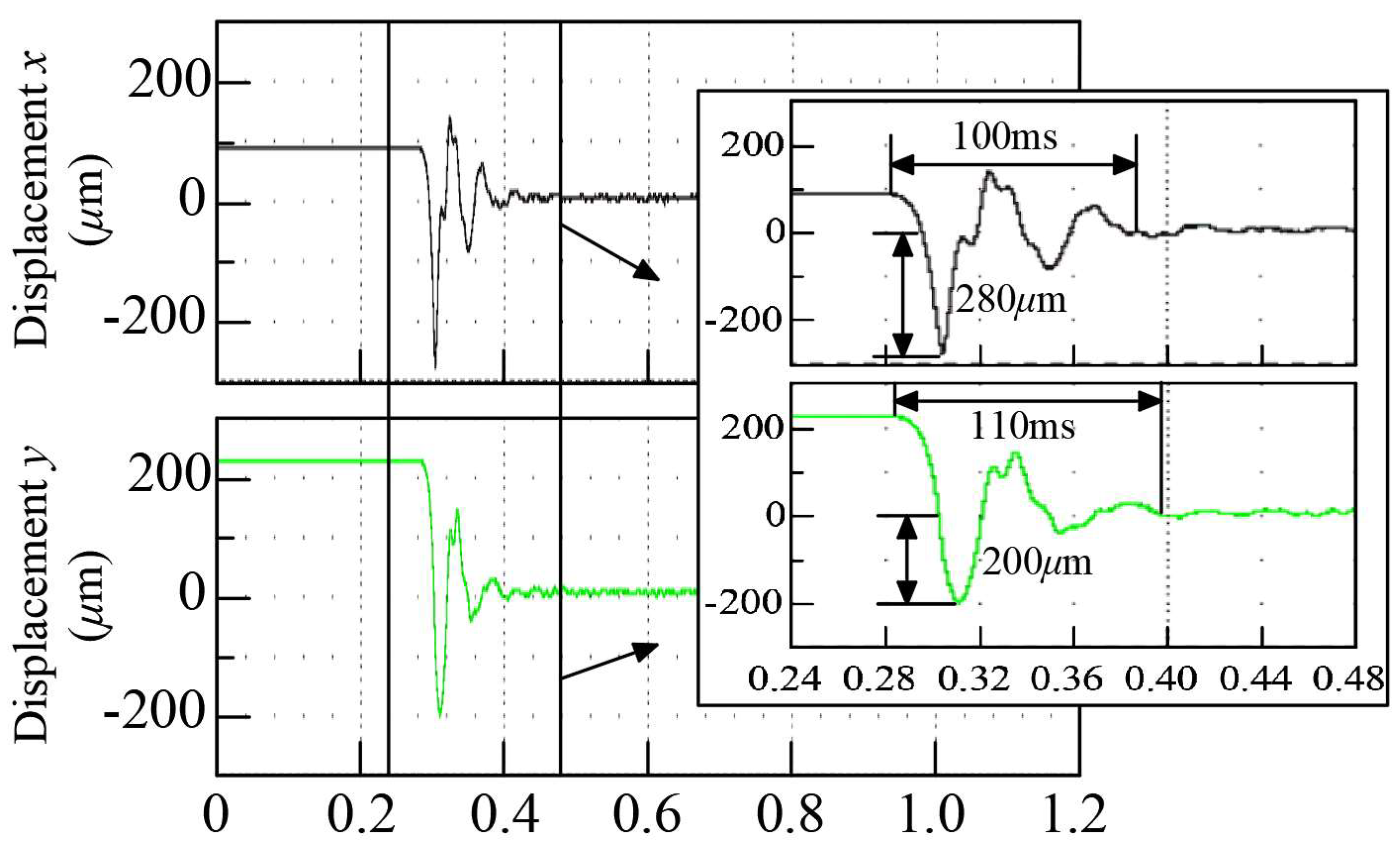


| Symbol | Parameter | Value |
|---|---|---|
| rs | Outer radius of the stator | 87 mm |
| rsi | Inner radius of the stator yoke | 67 mm |
| xc | Width of the stator pole | 20 mm |
| h | Length of the stator pole | 15.7 mm |
| ri | Outer radius of the isolation sleeve | 51.3 mm |
| rin | Inner radius of the isolation sleeve | 47.3 mm |
| rr | Outer radius of the rotor | 46.8 mm |
| δi | Thickness of the isolation sleeve | 4 mm |
| δ1 | Length of air gap 1 when the rotor is not eccentric | 0.5 mm |
| δ2 | Length of air gap 2 | 0.03 mm |
| l | Axial length of the stator | 40 mm |
| β | Radian between a pair of magnetic poles | 0.393 rad |
| θ | Radian of a single pole | 0.393 rad |
| α | Angle between the center lines of adjacent magnetic poles | 0.785 rad |
| I0 | Bias current | 1.6 A |
| N | Turn number of the coil | 180 |
Disclaimer/Publisher’s Note: The statements, opinions and data contained in all publications are solely those of the individual author(s) and contributor(s) and not of MDPI and/or the editor(s). MDPI and/or the editor(s) disclaim responsibility for any injury to people or property resulting from any ideas, methods, instructions or products referred to in the content. |
© 2023 by the authors. Licensee MDPI, Basel, Switzerland. This article is an open access article distributed under the terms and conditions of the Creative Commons Attribution (CC BY) license (https://creativecommons.org/licenses/by/4.0/).
Share and Cite
Zhang, R.; Song, X.; Cui, Z.; Hao, W.; Xu, C.; Song, L. Distributed Modeling of Isolated Active Magnetic Bearings Considering Magnetic Leakage and Material Nonlinearity. Energies 2023, 16, 8023. https://doi.org/10.3390/en16248023
Zhang R, Song X, Cui Z, Hao W, Xu C, Song L. Distributed Modeling of Isolated Active Magnetic Bearings Considering Magnetic Leakage and Material Nonlinearity. Energies. 2023; 16(24):8023. https://doi.org/10.3390/en16248023
Chicago/Turabian StyleZhang, Rui, Xinying Song, Zongze Cui, Wei Hao, Cong Xu, and Liwei Song. 2023. "Distributed Modeling of Isolated Active Magnetic Bearings Considering Magnetic Leakage and Material Nonlinearity" Energies 16, no. 24: 8023. https://doi.org/10.3390/en16248023
APA StyleZhang, R., Song, X., Cui, Z., Hao, W., Xu, C., & Song, L. (2023). Distributed Modeling of Isolated Active Magnetic Bearings Considering Magnetic Leakage and Material Nonlinearity. Energies, 16(24), 8023. https://doi.org/10.3390/en16248023






